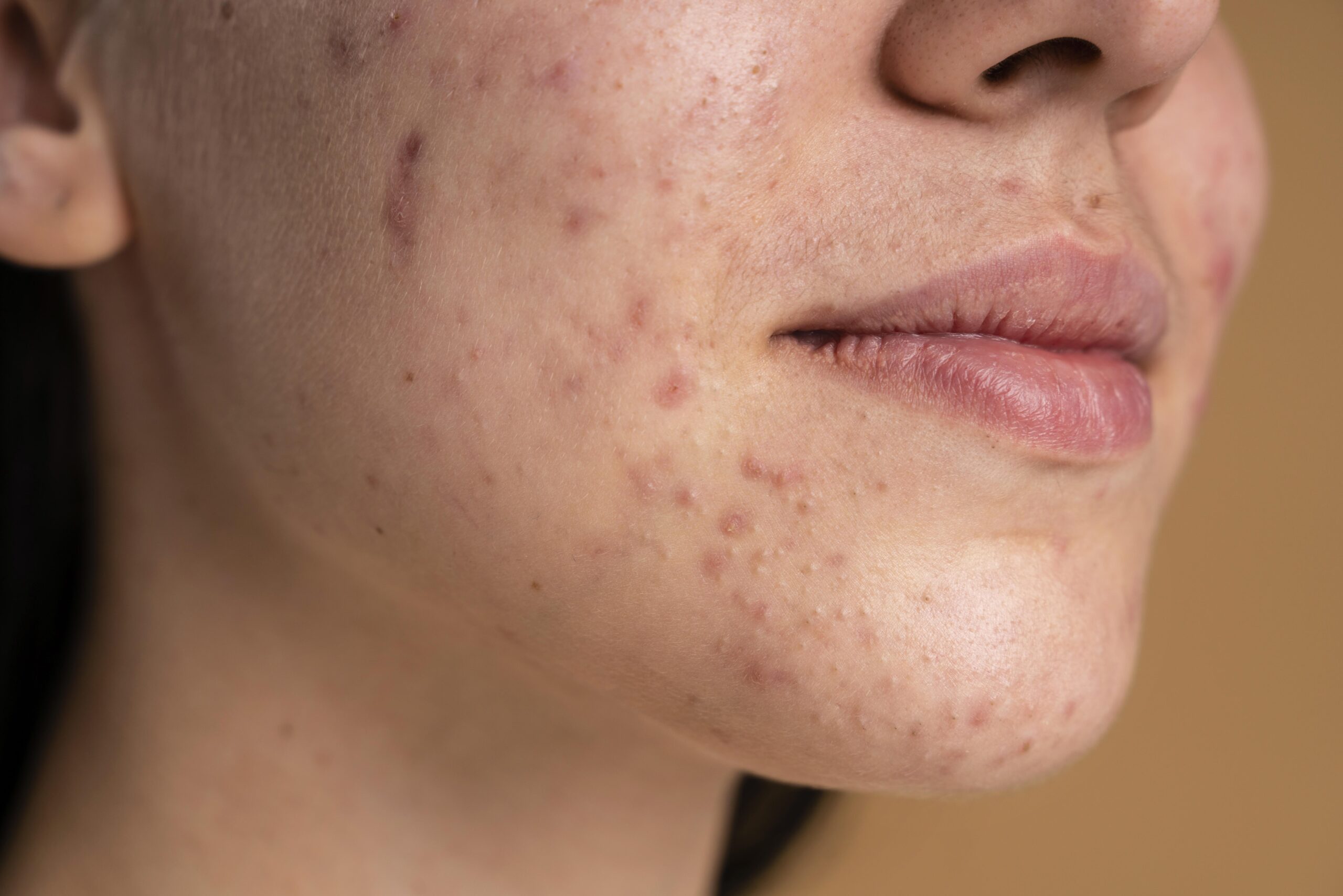Acne/Pimples
Home
Acne/Pimples
Acne/Pimples
Ayurvedic Treatment for Acne and Pimples: Causes, Types & Remedies
Acne, commonly known as pimples, is one of the most prevalent skin conditions affecting people of all ages. Characterized by inflammation, blackheads, whiteheads, and cysts, acne often leads to scarring, hyperpigmentation, and emotional stress. Ayurveda, the ancient Indian system of medicine, offers a holistic approach to manage acne by addressing its root causes, balancing doshas, and improving skin health naturally. This article explains Ayurvedic Treatment for Acne & Pimples – Clear Skin Guide, along with causes, types, and remedies for long-lasting results.

Ayurvedic Methods to Cure Acne
Ayurveda emphasizes a holistic acne treatment rather than merely treating surface symptoms. The treatment involves detoxification, herbal remedies, lifestyle modifications, and external therapies.
1. Internal Herbal Remedies
Ayurveda uses several herbs to treat acne by purifying blood, reducing inflammation, and balancing doshas:
- Neem (Azadirachta indica): Antibacterial and detoxifying; reduces inflammation.
- Turmeric (Curcuma longa): Anti-inflammatory and antioxidant properties help heal acne.
- Tulsi (Holy Basil): Balances Kapha and Pitta; purifies blood.
- Manjistha (Rubia cordifolia): Blood purifier and promotes healthy skin tone.
- Aloe Vera: Reduces redness, soothes irritation, and promotes healing.
These natural acne cures are a key part of Ayurvedic skin care for achieving acne-free, glowing skin.
2. Panchakarma Therapies
Detoxification therapies are effective in managing acne by removing Ama and balancing doshas:
- Virechana (Purgation Therapy): Eliminates excess Pitta and toxins from the body.
- Basti (Medicated Enema): Helps in Vata-related skin issues.
- Abhyanga (Herbal Oil Massage): Improves circulation and nourishes skin tissues.
- Nasya (Nasal Therapy): Helps in clearing toxins and preventing facial inflammation.
3. External Treatments
Topical Ayurvedic applications help reduce inflammation and heal skin naturally:
- Herbal Face Packs: Neem, turmeric, multani mitti (Fuller’s earth), and sandalwood powders are mixed with rose water or aloe vera for paste application.
- Oil Treatments: Application of sesame or coconut oil with herbal powders can soothe irritated skin.
- Steam Therapy: Herbal steam using tulsi, neem, and chamomile opens pores and removes toxins.
4. Dietary Management
A balanced diet is critical to reduce acne:
- Eat fresh fruits, green leafy vegetables, and whole grains.
- Avoid oily, fried, processed foods, and excess dairy.
- Drink plenty of water to flush out toxins.
- Incorporate herbal teas such as coriander, fennel, or neem for detoxification.
5. Lifestyle Modifications
- Maintain daily skin hygiene by cleansing gently twice a day.
- Practice stress-relieving activities like yoga and meditation.
- Ensure adequate sleep for skin regeneration.
Avoid excessive exposure to pollution and sun, use herbal sunscreen if necessary.
Benefits of Ayurvedic Acne Treatment
Ayurvedic Treatment for Acne & Pimples – Clear Skin Guide highlights the following benefits:
- Targets the Root Cause: Balances doshas and removes toxins rather than just suppressing symptoms.
- Reduces Inflammation Naturally: Herbal remedies soothe irritated skin without side effects.
- Prevents Recurrence: Lifestyle guidance and diet management reduce flare-ups.
- Promotes Overall Skin Health: Enhances immunity and improves skin texture and tone.
- Safe and Non-invasive: Uses natural herbs and therapies with minimal side effects.
Causes of Acne in Ayurveda
In Ayurveda, acne is referred to as Yauvan Pidika or Mukha Pidika, primarily caused due to an imbalance of the Pitta and Kapha doshas, which leads to toxin accumulation (Ama) in the body. Several factors contribute to the onset of acne:
1. Climatic Changes
Climate has a direct effect on skin health. Extreme weather conditions can aggravate dosha imbalances and worsen acne:
- Hot and Humid Climate: Increases Pitta dosha, leading to inflammation, redness, and oily skin, which can trigger acne breakouts.
- Cold and Dry Climate: Aggravates Vata dosha, causing dry, flaky skin that can lead to clogged pores.
- Seasonal Changes: Sudden changes in weather, such as winter to summer, can disrupt skin balance and provoke acne flare-ups.
- Excessive Sun Exposure: Leads to oxidative stress, Pitta aggravation, and increased pigmentation.
2. Dietary Factors
Poor dietary habits are major contributors to acne:
- Consuming excess oily, fried, and processed foods increases Kapha dosha and skin oiliness.
- High intake of sugar, dairy products, and refined carbohydrates can promote inflammation.
- Irregular meal timings and overeating disturb Agni (digestive fire), leading to Ama accumulation, which manifests as acne.
3. Lifestyle Factors
- Lack of proper sleep and rest disrupts natural skin regeneration.
- Excessive stress triggers hormonal imbalances, aggravating Pitta and Kapha doshas.
- Poor hygiene and excessive touching of the face spread bacteria and block pores.
4. Hormonal Imbalance
Hormonal fluctuations, particularly during puberty, menstruation, pregnancy, or due to conditions like PCOS, increase sebum production, creating an environment for acne.
Preventive Measures for Acne
Prevention is easier than cure. Ayurveda emphasizes maintaining skin health through:
- Avoiding stress and mental tension which aggravates Pitta and Kapha.
- Using herbal face washes instead of chemical-based products.
- Regular oil massages to balance Vata and improve circulation.
- Seasonal detoxification to maintain dosha balance.
- Drinking herbal decoctions like neem, turmeric, and manjistha for blood purification.
Types of Acne and Pimples
Understanding the type of acne is crucial for effective treatment. Ayurvedic Treatment for Acne & Pimples – Clear Skin Guide classifies acne based on dosha involvement and severity:
1. Vata Type Acne
- Characterized by dry, scaly, and small pimples.
- Associated with Vata imbalance.
- Often occurs during cold weather or periods of stress and dehydration.
2. Pitta Type Acne
- Red, inflamed, and painful pimples with pus formation.
- Common in hot, humid climates.
- May cause burning sensation and scars if untreated.
3. Kapha Type Acne
- Large, swollen, and oily pimples that are slow to heal.
- Often occurs on the chin, jawline, or forehead.
- Associated with oily skin and mucus accumulation
4. Mixed Type Acne
- Combination of two or more doshas.
- Requires personalized treatment to balance multiple doshas simultaneously.
